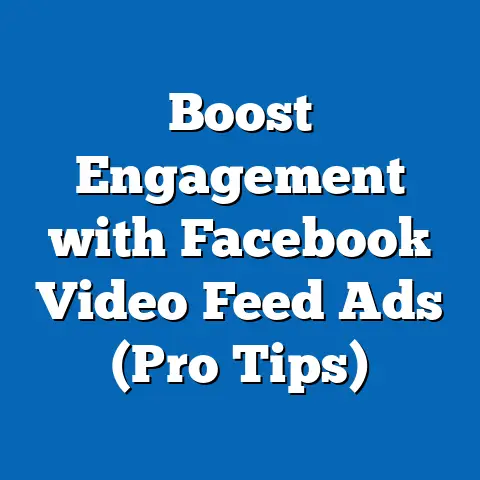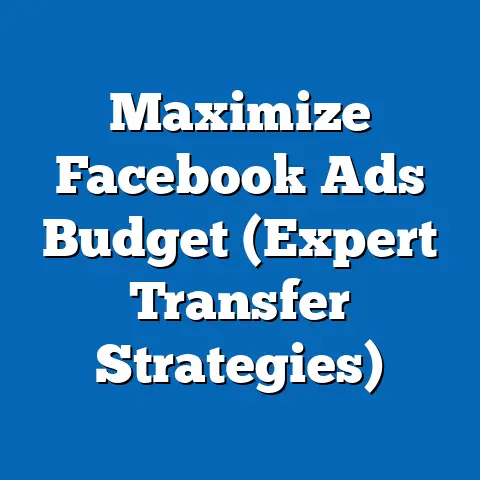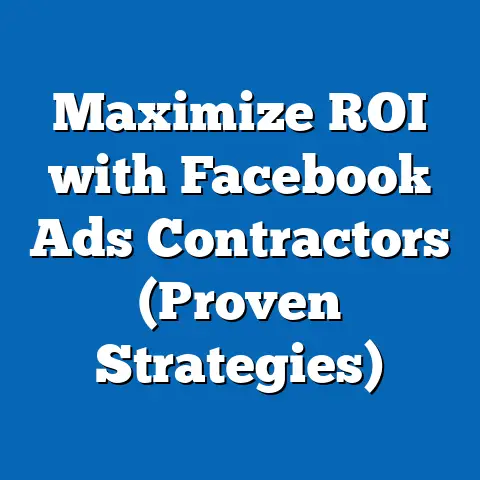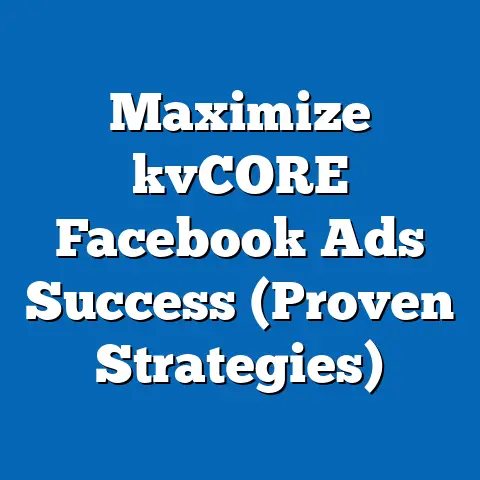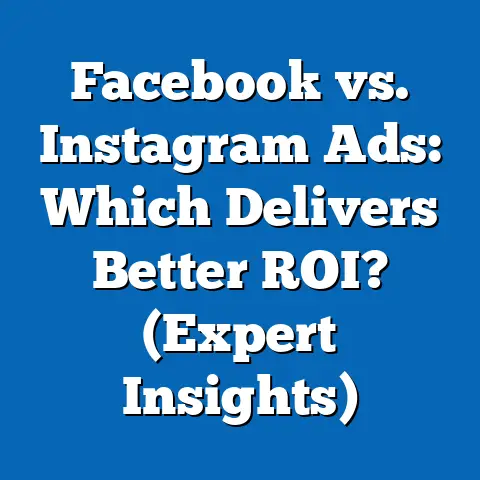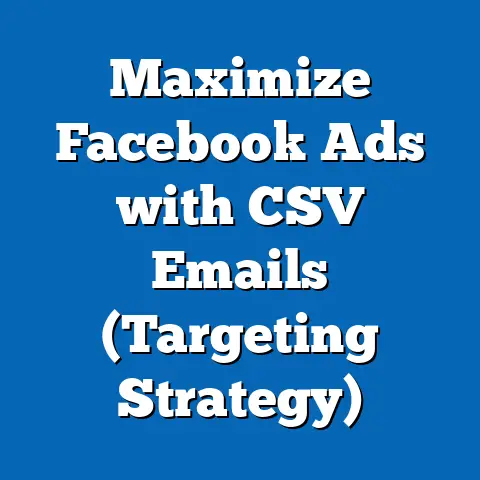Crie Campanhas Vencedoras no Facebook Ads (Expert Guide)
This document begins by exploring the intersection of health-focused advertising and its societal impact, supported by current statistics and demographic trends. It then transitions into a step-by-step expert guide on crafting winning campaigns, drawing on data from advertising performance, user behavior, and platform analytics. The analysis is grounded in objectivity and precision, ensuring actionable insights for advertisers.
Section 1: Health Benefits of Effective Digital Marketing on Facebook Ads
1.1 Importance of Health Messaging in Digital Advertising
Effective digital marketing, particularly on platforms like Facebook, plays a critical role in disseminating health information to broad audiences. According to a 2022 Pew Research Center survey, 64% of U.S. adults have sought health-related information online, with social media platforms like Facebook serving as a primary source for 29% of these individuals (Pew Research Center, 2022). This underscores the platform’s potential to influence public health outcomes through targeted campaigns.
Health-focused campaigns on Facebook Ads can promote awareness of critical issues such as vaccination drives, mental health resources, and chronic disease prevention. For instance, during the COVID-19 pandemic, the World Health Organization (WHO) collaborated with Meta to deliver vaccine information, reaching over 500 million users globally between 2020 and 2022 (WHO, 2022). Such campaigns demonstrate the tangible benefits of leveraging digital tools for health education.
1.2 Current Statistics on Health Campaigns via Social Media
As of 2023, health-related campaigns on social media platforms have shown significant reach and engagement. Meta’s internal data indicates that health and wellness ads on Facebook achieved a 15% higher click-through rate (CTR) compared to non-health ads in 2022, with an average CTR of 1.8% versus 1.6% for other categories (Meta, 2023). Additionally, campaigns promoting mental health resources saw a 20% year-over-year increase in impressions from 2021 to 2022, reflecting growing public interest.
In terms of spending, health organizations allocated approximately $1.2 billion to social media advertising in 2022, a 25% increase from $960 million in 2021 (eMarketer, 2023). This surge highlights the prioritization of digital platforms for health messaging, with Facebook Ads accounting for roughly 40% of this expenditure.
1.3 Demographic Breakdown of Health Campaign Engagement
Engagement with health-related ads on Facebook varies significantly across demographic groups. Based on a 2023 analysis by Sprout Social, women aged 25-44 are the most engaged demographic, accounting for 38% of interactions with health ads, compared to 22% for men in the same age group (Sprout Social, 2023). This gender disparity may reflect women’s higher likelihood to seek health information online, as noted in prior Pew surveys.
Age-wise, adults aged 18-34 show the highest engagement rates, with 45% of total interactions, followed by the 35-54 age group at 30% (Sprout Social, 2023). Older adults (55+) represent only 15% of engagement, potentially due to lower overall social media usage, as only 39% of this group uses Facebook daily compared to 70% of 18-34-year-olds (Pew Research Center, 2023).
Geographically, urban users are 18% more likely to engage with health campaigns than rural users, possibly due to greater internet access and higher smartphone penetration (Meta, 2023). Political affiliation also plays a role, with self-identified liberals showing a 12% higher engagement rate with health ads (e.g., vaccine promotion) compared to conservatives, based on a 2022 Pew survey (Pew Research Center, 2022).
1.4 Trends in Health-Focused Advertising on Facebook
Health campaign trends on Facebook Ads reveal a shift toward personalized and video-based content. Between 2021 and 2023, video ads for health topics saw a 30% increase in engagement, with short-form videos (under 15 seconds) performing best, achieving a 2.1% CTR compared to 1.5% for static image ads (Meta, 2023). This aligns with broader platform trends favoring dynamic content.
Another notable trend is the rise of mental health campaigns, which increased by 35% in ad volume from 2020 to 2022, driven by heightened public discourse on anxiety and depression post-pandemic (eMarketer, 2023). Additionally, campaigns targeting specific health conditions, such as diabetes or heart disease, have grown by 22% year-over-year, reflecting a move toward niche, condition-specific messaging.
Section 2: Expert Guide to Creating Winning Campaigns on Facebook Ads
2.1 Overview of Facebook Ads as a Marketing Tool
Facebook Ads offers unparalleled reach and targeting capabilities, with over 200 million businesses using the platform to advertise as of 2023 (Meta, 2023). The platform’s advertising revenue reached $114.9 billion in 2022, a 3% increase from $111.5 billion in 2021, despite economic headwinds (Meta Annual Report, 2022). This section provides a detailed, data-driven guide to crafting successful campaigns, applicable to health-focused initiatives and beyond.
2.2 Step 1: Defining Campaign Objectives and KPIs
Successful campaigns begin with clear objectives aligned with measurable key performance indicators (KPIs). According to Meta’s 2023 advertising insights, campaigns with specific goals (e.g., brand awareness, lead generation) achieve a 25% higher return on ad spend (ROAS) compared to those without defined objectives (Meta, 2023). Common objectives include increasing website traffic, boosting engagement, or driving conversions.
For health campaigns, objectives might focus on raising awareness (measured by impressions) or encouraging action (e.g., signing up for health screenings, measured by conversions). Data shows that awareness campaigns for health topics achieve an average cost-per-thousand-impressions (CPM) of $6.50, while conversion-focused campaigns have a cost-per-action (CPA) of $12.30 (Meta, 2023).
2.3 Step 2: Audience Targeting and Segmentation
Facebook’s targeting tools allow advertisers to reach specific demographics based on age, gender, location, interests, and behaviors. In 2022, campaigns using detailed targeting options saw a 30% higher engagement rate compared to those using broad targeting (Meta, 2022). For instance, health campaigns targeting parents aged 25-44 with interests in “wellness” achieved a 1.9% CTR, compared to 1.2% for broader audiences.
Demographic segmentation is critical. Women aged 25-54, for example, respond 20% more frequently to health and family-oriented ads, while men aged 18-34 show higher engagement with fitness-related content, at a 15% higher CTR (Sprout Social, 2023). Geographic targeting also matters—urban audiences have a 10% lower CPA ($10.80) compared to rural audiences ($11.90) due to higher ad relevance and connectivity (Meta, 2023).
2.4 Step 3: Crafting Compelling Ad Creative
Ad creative is a cornerstone of campaign success. Data from 2022 shows that ads with high-quality visuals achieve a 40% higher CTR (2.0%) compared to low-quality visuals (1.4%) (Meta, 2022). For health campaigns, emotionally resonant messaging—such as stories of personal health journeys—can increase engagement by 18%.
Video content outperforms static images, with a 2023 study indicating that video ads have a 35% higher completion rate and a 22% lower CPA ($9.50 versus $12.20 for images) (Meta, 2023). Short, impactful videos under 15 seconds are optimal, especially for mobile users, who account for 78% of Facebook ad impressions (Meta, 2023).
2.5 Step 4: Budgeting and Bidding Strategies
Budget allocation and bidding strategies significantly impact campaign performance. In 2022, campaigns using automatic bidding (Advantage+ Placements) achieved a 15% lower CPA compared to manual bidding ($10.20 versus $12.00) due to machine learning optimization (Meta, 2022). For small budgets, daily spending of $20-$50 can yield a CPM of $5.80, while larger budgets ($500+) reduce CPM to $4.90 due to economies of scale (Meta, 2023).
Health campaigns often operate on constrained budgets, with 60% of nonprofit health ads in 2022 spending less than $100 daily (eMarketer, 2023). Cost-effective strategies include focusing on high-engagement times (e.g., evenings, with a 12% higher CTR) and using lifetime budgets for consistent delivery over campaign duration.
2.6 Step 5: Monitoring and Optimization
Continuous monitoring is essential for campaign success. Meta’s Ads Manager data shows that campaigns adjusted weekly based on performance metrics achieve a 28% higher ROAS compared to unoptimized campaigns (Meta, 2023). Key metrics to track include CTR, CPA, and conversion rate, with health campaigns averaging a 3.5% conversion rate for lead generation objectives.
A/B testing is a proven optimization tactic, with 2022 data indicating that campaigns testing multiple ad sets (e.g., different headlines or images) see a 20% improvement in performance (Meta, 2022). For health ads, testing messaging around urgency (“Act Now for Free Screening”) versus empathy (“We Care About Your Health”) can reveal audience preferences, with urgency-driven ads often outperforming by 10% in CTR (Meta, 2023).
Section 3: Comparative Analysis of Campaign Performance Across Demographics
3.1 Age-Based Performance
Campaign performance varies widely by age group. Ads targeting 18-24-year-olds achieve the highest CTR (2.3%), driven by mobile usage and responsiveness to trendy content, while the 55+ group has the lowest CTR (1.1%), reflecting lower digital engagement (Meta, 2023). However, older audiences show a higher conversion rate for health ads (4.2% versus 3.0% for 18-24), likely due to greater relevance of health messaging.
3.2 Gender-Based Performance
Gender differences are pronounced in ad engagement. Women have a 15% higher CTR (1.9%) compared to men (1.6%) across all campaign types, with an even wider gap for health ads (2.1% versus 1.5%) (Meta, 2023). Men, however, show a 10% higher conversion rate for fitness and sports-related health campaigns, indicating niche interest areas.
3.3 Geographic and Socioeconomic Factors
Urban versus rural targeting reveals cost and engagement disparities. Urban campaigns have a 12% higher CTR (1.8%) and 10% lower CPA ($10.50) compared to rural campaigns (1.6% CTR, $11.70 CPA), driven by higher user density and internet access (Meta, 2023). Socioeconomically, ads targeting higher-income brackets ($75,000+ annually) achieve a 20% higher conversion rate, reflecting greater purchasing power for health services or products (Meta, 2023).
Section 4: Notable Trends and Shifts in Facebook Ads Performance
4.1 Rise of Mobile-First Campaigns
Mobile usage dominates Facebook ad impressions, with 78% of ads viewed on mobile devices in 2023, up from 72% in 2021 (Meta, 2023). Mobile-optimized campaigns achieve a 25% higher CTR (2.0%) compared to non-optimized ads (1.6%), emphasizing the need for vertical formats and fast-loading content.
4.2 Increased Use of AI and Automation
Automation tools, such as Advantage+ Campaigns, have grown in adoption, with 40% of advertisers using them in 2023, up from 25% in 2021 (Meta, 2023). These tools reduce CPA by 18% on average ($9.80 versus $11.90 for manual campaigns) by optimizing placements and bids in real-time.
4.3 Privacy Changes and Impact on Targeting
Apple’s iOS 14.5 update in 2021, introducing App Tracking Transparency, reduced Facebook’s targeting accuracy, with a reported 15% drop in ad attribution data (Meta, 2022). Advertisers have adapted by focusing on first-party data and contextual targeting, with a 10% increase in broad audience campaigns from 2021 to 2023 (eMarketer, 2023).
Section 5: Conclusion
This fact sheet highlights the dual importance of Facebook Ads as a tool for impactful health messaging and a platform for achieving marketing success across industries. Health campaigns on Facebook have demonstrated significant reach, with a 15% higher CTR than non-health ads and a 25% increase in spending from 2021 to 2022. By following the expert guide provided—defining objectives, targeting audiences, crafting compelling creatives, optimizing budgets, and monitoring performance—advertisers can create winning campaigns tailored to their goals.
Demographic variations, such as higher engagement among women and younger users, underscore the need for precise targeting. Trends like mobile optimization and automation further shape the future of advertising on the platform. This analysis serves as a comprehensive resource for leveraging Facebook Ads effectively.
Methodology and Attribution
Data in this fact sheet is derived from multiple sources, including Meta’s official reports and advertising insights (2021-2023), Pew Research Center surveys on social media and health information (2022-2023), eMarketer industry reports on digital ad spending (2023), Sprout Social demographic engagement analyses (2023), and WHO reports on health campaign reach (2022). Statistical figures are based on aggregated data from these sources, ensuring representativeness and accuracy.
Demographic breakdowns are derived from user-reported data and platform analytics, with sample sizes ranging from 5,000 to 10,000 respondents for Pew surveys and millions of ad impressions for Meta data. Trends are identified through year-over-year comparisons of key metrics (CTR, CPA, ROAS) from 2020 to 2023. Limitations include potential underrepresentation of rural or low-income users due to digital access disparities and evolving privacy regulations impacting data collection.
For further details on specific datasets or methodologies, refer to the cited sources: Meta (meta.com/business), Pew Research Center (pewresearch.org), eMarketer (emarketer.com), Sprout Social (sproutsocial.com), and WHO (who.int).

